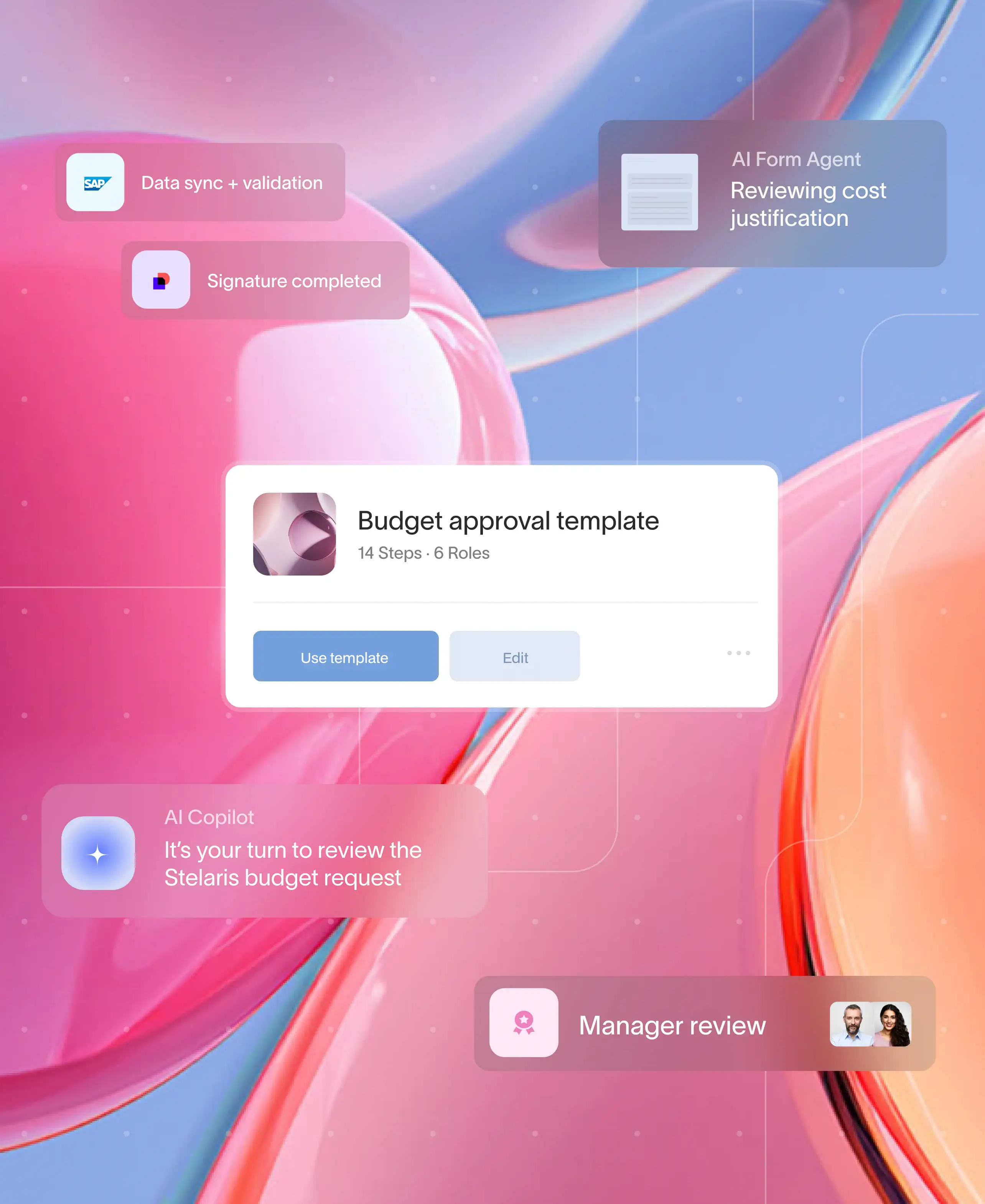.jpg)
Client onboarding is the starting point in establishing a lasting business relationship. First impressions matter, and a seamless experience while onboarding clients can set the tone with your company. Automating the client onboarding process can significantly enhance the client experience, ensuring efficiency and satisfaction from the start. In this blog, we look at the benefits you can unlock once your organization automates client onboarding.
What is client onboarding?
Client onboarding is the process of introducing new clients to your business, services, and processes. It involves various steps, such as gathering client information, setting up the account, providing necessary training, and ensuring the client is well-acquainted with your offerings. An effective onboarding process is crucial for building trust and fostering a positive client relationship.
Why is automating client onboarding important?
Automating client onboarding is vital for several reasons.
- First, it reduces manual workload and minimizes the risk of human error, ensuring a smoother onboarding experience.
- Second, automation accelerates the client onboarding process, allowing them to benefit from your services sooner.
- Lastly, it provides consistency and standardization, ensuring that all clients receive high-quality onboarding experience.
Understanding your customers' needs is the crucial first step before automating the onboarding process. By thoroughly analyzing different customer segments, businesses can identify which groups are best suited for self-service onboarding. This involves evaluating factors such as technological proficiency, complexity of the product or service, and specific customer preferences.
For example, a tech-savvy segment using a straightforward product might benefit from a fully automated customer onboarding process, while more complex customer segments might require a hybrid approach, combining automated elements with personalized support. This tailored analysis ensures that the onboarding process is efficient, relevant, and user-friendly for each segment. On-boarding is both an art and a science as there are metrics you can look at to see how effective your client onboarding process is.
How to automate the client onboarding process
Before automating your customer onboarding, it's crucial to define the goals of the automation. Decide whether the entire onboarding process can be automated or if automation is only feasible for specific customer segments.
- Identify key steps in the onboarding journey
- Use customer relationship management (CRM) systems
- Automate document management
- Implement automated workflows
- Develop an automated onboarding checklist
1. Identify key steps in the onboarding journey
Understanding the client onboarding journey in its entirety is the first step towards effective automation. Begin by mapping out the entire process, from the initial contact with the client to their full integration into your system or service. Regardless of the industry there will always be certain client onboarding milestones you need to look out for.
Break down each phase—whether it’s the introductory call, data collection, training, or final handoff—and identify the tasks that are repetitive or prone to delays. For example, if clients often encounter bottlenecks during the document review stage, consider implementing automated reminders or pre-filled forms to expedite the process. By pinpointing and addressing these areas, you can create a smoother and more efficient onboarding experience that minimizes friction and enhances client satisfaction.
2. Use customer relationship management (CRM) systems
Implementing a robust Customer Relationship Management (CRM) system is crucial for managing client data, tracking progress, and automating communication throughout the onboarding process. A CRM centralizes all client interactions, making it easier to provide personalized service and maintain consistency across departments.
For instance, sales teams can seamlessly hand off client information to the customer success team, ensuring that no details are lost. Moreover, a CRM can generate valuable insights through data analysis, helping to refine and improve the onboarding process over time. By leveraging CRM tools, you can automate follow-ups, segment clients based on their needs, and deliver a more tailored and effective onboarding experience.
3. Automate document management
The document management process can often be a significant hurdle in client onboarding, especially when it involves multiple stakeholders and approvals. To streamline this process, utilize digital signature solutions and cloud storage to handle contracts and other important documents seamlessly.
Digital signature tools like DocuSign or Adobe Sign not only speed up the signing process but also enhance security and compliance by ensuring that documents are signed and stored in a legally binding and encrypted environment. Additionally, cloud storage allows clients to access and review documents at their convenience, reducing delays and improving their overall experience. By automating document management, you reduce manual errors, save time, and provide clients with a more efficient and user-friendly onboarding process.
4. Implement automated workflows:
Automated workflows are the key to guiding clients through each step of the onboarding process, ensuring that no steps are missed and that clients are always informed of their progress. Automation tools can be used to create workflows that trigger actions and send notifications as needed.
For example, when a client completes a training module, an automated workflow can send them a congratulatory email along with the next steps, such as scheduling a follow-up meeting or completing a feedback survey. This not only keeps the onboarding process moving smoothly but also reduces the workload on staff, allowing them to focus on more strategic tasks. Automated workflows increase transparency for clients, providing them with a clear view of where they stand in the onboarding journey and what to expect next.
5. Develop an automated onboarding checklist
An automated onboarding checklist ensures that all necessary tasks are completed in the correct sequence, preventing any steps from being overlooked. This checklist can be integrated into your CRM or project management tools, providing a clear roadmap for both your team and the client.
For instance, the checklist might include tasks such as data entry, contract signing, training sessions, and software installations. By automating the onboarding checklist, you can set up automatic reminders and follow-ups to ensure that deadlines are met and that each step is completed on time. This not only keeps the onboarding process on track but also gives clients confidence that their onboarding is being handled with precision and care.
With a well-structured checklist in place, your team can focus on delivering personalized service, while the automation handles routine tasks. This balance between automation and human touch is key to a successful onboarding experience.
Best practices for automating client onboarding
Automating the client onboarding process is a powerful way to enhance efficiency, reduce manual errors, and improve the overall client experience. However, to achieve the best results, it's crucial to implement automation thoughtfully and strategically. Let’s take a look at some common best practices for automated customer on-boarding:
- Personalize communication
- Regularly update onboarding material
- Monitor and optimize
- Provide self-service options
- Ensure security and compliance
1. Personalize communication
While automation handles the bulk of the process, ensure that you have personalized communication with clients to maintain a human touch. You can create automated onboarding emails tailored to each user’s role and use case. New users should receive personalized messages addressing their specific needs, such as a project manager getting tips on team collaboration, while developers receive information on integrating with development tools.
2. Regularly update onboarding material:
Keep your client onboarding content and training materials current to reflect any changes in your services or processes. This ensures that new users always have the latest information, reducing confusion and enhancing their understanding of the platform’s capabilities.
3. Monitor and optimize
Continuously monitor the automated customer onboarding process and gather feedback to make improvements. By tracking metrics such as completion rates of onboarding steps and user feedback, you can continuously refine the process, making it smoother and more engaging for new onboardees.
4. Provide self-service options
Empower clients with self-service portals where they can access information, complete tasks, and track their progress. Marketing can provide insights into customer behavior and preferences, helping to craft personalized onboarding messages and content. Sales teams can offer valuable feedback on common customer questions and pain points, ensuring that the onboarding process addresses these issues effectively. Customer service can highlight areas where customers typically require support, guiding the design of automated help features.
5. Ensure security and compliance
Use secure platforms to handle sensitive client information and ensure compliance with relevant regulations. Using encrypted channels for data transfer, and complying with regulations like GDPR and PCI DSS builds trust and ensures that client data is handled responsibly.
How Moxo helps automate the client onboarding process
Moxo offers a comprehensive solution to automate client onboarding, streamlining the entire process from start to finish. With Moxo, you can create customized onboarding workflows, automate document collection, and ensure consistent communication. The platform’s client portal provides a centralized hub for clients to access all necessary information and complete onboarding tasks efficiently. By leveraging Moxo's capabilities, businesses can automate and enhance the client onboarding experience, reduce manual effort, and ensure a smooth transition for new clients.
Conclusion
Automating the client onboarding process is essential for delivering a seamless and efficient client experience. By embracing customer onboarding automation, businesses can improve accuracy, speed, and consistency, setting the stage for successful long-term relationships. Tools like Moxo can play a pivotal role in achieving these goals, ensuring that your onboarding process is not only efficient but also client-centric.
Get Started with Moxo to create on-boarding workflows tailor made for your customers!
FAQs
What are the benefits of automating client onboarding?
Automating client onboarding improves efficiency, reduces errors, accelerates the process, and ensures a consistent and high-quality experience for all clients.
How can Moxo assist with client onboarding automation?
Moxo provides a platform for creating customized onboarding workflows, automating document management, and maintaining consistent communication, enhancing the overall client onboarding experience.
What is an automated onboarding checklist?
An automated onboarding checklist is a list of tasks required for onboarding a client, managed and executed through automation to ensure all steps are completed systematically.
Why is customer onboarding automation important?
Customer onboarding automation is crucial for reducing manual workload, minimizing errors, speeding up the onboarding process, and providing a consistent experience for all clients.
How can businesses ensure a smooth automated onboarding process?
Businesses can ensure a smooth automated onboarding process by mapping out the onboarding journey, implementing CRM systems, using digital document management, and continuously monitoring and optimizing the process.





